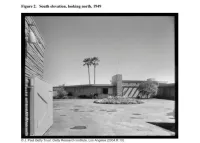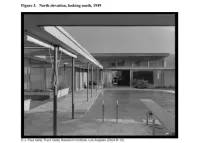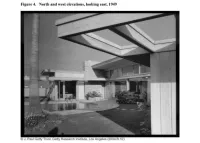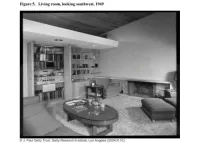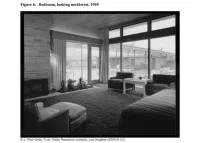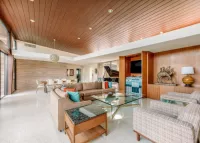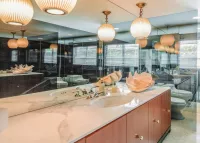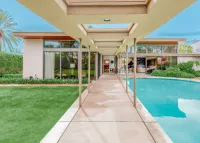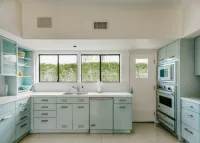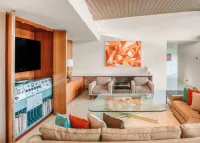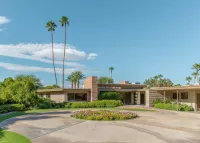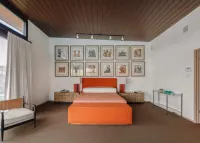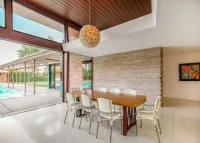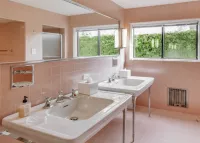Share what you know,
and discover more.
Share what you know,
and discover more.
Dec 27, 2016
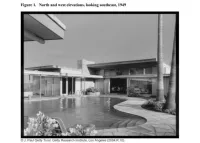
-

- Dave D
National Register of Historic Places
Excerpts from the National Register of Historic Places Registration Form Summary: The Frank Sinatra Residence was E. Stewart Williams’ first residential commission in Palm Springs. The single-family desert vacation house was commissioned by Sinatra in the summer of 1946 and completed in 1947. Williams’ design for a modern ranch-style house won out over the Georgian Revival mansion that Sinatra had initially requested. The 4,500 square foot dwelling is of wood frame construction with a flat and shed roof, open floor plan, large expanses of glazing including sliding glass doors, and a stucco exterior finish that replaced the original redwood siding. Original window frames, glazing, entry doors, and sliding glass doors have been replaced. In addition, concrete decking instead of flagstone now surrounds the large swimming pool. Despite alterations, the overall building exhibits sufficient historic integrity to convey its significance. Narrative: Designed early in E. Stewart Williams’ Palm Springs career, the Frank Sinatra Residence exhibits many elements that would appear in the architect’s residential commissions over the next 40 years: flat or shed roofs, deep overhangs, large expanses of fixed glazing, sliding glass doors, and, most importantly, the integration of natural materials into his modern designs. Inspired by modern ranch-style houses of the early postwar period, the Frank Sinatra Residence is laid out at a casual angle somewhat like a pinwheel instead of a typical grid. The large house contains four bedrooms and seven bathrooms and is capped by both a shed and flat roof. Exterior elevations originally sheathed in redwood siding were refinished in stucco in the 1990s due to extensive deterioration of the wood from many years of neglect in the harsh desert environment. In order “to make the house feel as if it were part of the desert landscape,” said Williams, “instead of walls I put in glass.” Given its remote location at the time near the town’s airfield, this was a feasible goal. A pair of backyard Mexican Fan Palms that have since grown to remarkable height are the Twin Palms for which the property was originally named. With Sinatra’s fondness for entertaining in mind, the house was designed with a large, open-plan living room and dining area with sliding glass doors adjacent to the swimming pool. The bedroom wings are on opposite sides of the living room with the master bedroom’s floor-to-ceiling windows facing Mt. San Jacinto. The two prominent chimneys are of Arizona flagstone, floors are terrazzo, and ceilings are finished in natural wood. Approaching the house from the north, a concrete walkway is shaded by a flat canopy supported by steel posts. What makes this canopy unique are its square cutouts that, when the sun is directly above, give the effect of piano keys for the adjacent grand piano-shaped swimming pool. A freestanding cabana with its angled flat roof and deep overhangs are located on the north side of the swimming pool. Another distinctive feature is the original high-fidelity recording equipment in the living room. Apparently, Sinatra made musical recordings with the equipment using a special disc-engraving device. The dwelling’s south elevation is the original approach to the house via a circular driveway. A small carport is to the east while the entrance is in the elbow of the L-shaped portion of the house. The living room’s large flagstone chimney is the dominant visual element of this façade. Building permits documenting alterations to the property were not located by the city except for ones related to the remodeling of the kitchen in 2009. In the early 2000s, the primary approach to the property was changed from the south driveway off of busy Alejo Road to the dramatic poolside walkway with its perforated canopy on the north side of the parcel through East Via Colusa Road. This did not result in any physical modification to the dwelling. As noted, the original board-and-batten siding was removed due to deterioration in the 1990s, and a stucco finish applied to exterior surfaces. A comparison with historic photographs reveals that the original flagstone decking around the swimming pool has been replaced with concrete, and the dwelling’s windows, entry doors, sliding glass doors and their respective frames have been replaced with contemporary materials. Despite these changes, the overall integrity of design, materials, and workmanship is such that the Frank Sinatra Residence is able to convey its architectural significance. The property retains the essential physical features associated with the residential work of E. Stewart Williams. These features include a flat and shed roof, deep overhangs, large expanses of glazing with sliding glass doors for indoor-outdoor flow, and an open floor plan. In addition, the design incorporates Arizona flagstone for several prominent chimneys and natural wood for ceilings. This melding of the natural environment with modern design precepts is key to Williams’ architectural philosophy. The residence retains integrity of association as it continues to be known and promoted as the Frank Sinatra Residence and used as a single-family residence. The dwelling is at its original location and the setting has been retained. Because of these factors, the integrity of feeling also remains high.
National Register of Historic Places
Excerpts from the National Register of Historic Places Registration Form Summary: The Frank Sinatra Residence was E. Stewart Williams’ first residential commission in Palm Springs. The single-family desert vacation house was commissioned by Sinatra in the summer of 1946 and completed in 1947. Williams’ design for a modern ranch-style house won out over the Georgian Revival mansion that Sinatra had initially requested. The 4,500 square foot dwelling is of wood frame construction with a flat and shed roof, open floor plan, large expanses of glazing including sliding glass doors, and a stucco exterior finish that replaced the original redwood siding. Original window frames, glazing, entry doors, and sliding glass doors have been replaced. In addition, concrete decking instead of flagstone now surrounds the large swimming pool. Despite alterations, the overall building exhibits sufficient historic integrity to convey its significance. Narrative: Designed early in E. Stewart Williams’ Palm Springs career, the Frank Sinatra Residence exhibits many elements that would appear in the architect’s residential commissions over the next 40 years: flat or shed roofs, deep overhangs, large expanses of fixed glazing, sliding glass doors, and, most importantly, the integration of natural materials into his modern designs. Inspired by modern ranch-style houses of the early postwar period, the Frank Sinatra Residence is laid out at a casual angle somewhat like a pinwheel instead of a typical grid. The large house contains four bedrooms and seven bathrooms and is capped by both a shed and flat roof. Exterior elevations originally sheathed in redwood siding were refinished in stucco in the 1990s due to extensive deterioration of the wood from many years of neglect in the harsh desert environment. In order “to make the house feel as if it were part of the desert landscape,” said Williams, “instead of walls I put in glass.” Given its remote location at the time near the town’s airfield, this was a feasible goal. A pair of backyard Mexican Fan Palms that have since grown to remarkable height are the Twin Palms for which the property was originally named. With Sinatra’s fondness for entertaining in mind, the house was designed with a large, open-plan living room and dining area with sliding glass doors adjacent to the swimming pool. The bedroom wings are on opposite sides of the living room with the master bedroom’s floor-to-ceiling windows facing Mt. San Jacinto. The two prominent chimneys are of Arizona flagstone, floors are terrazzo, and ceilings are finished in natural wood. Approaching the house from the north, a concrete walkway is shaded by a flat canopy supported by steel posts. What makes this canopy unique are its square cutouts that, when the sun is directly above, give the effect of piano keys for the adjacent grand piano-shaped swimming pool. A freestanding cabana with its angled flat roof and deep overhangs are located on the north side of the swimming pool. Another distinctive feature is the original high-fidelity recording equipment in the living room. Apparently, Sinatra made musical recordings with the equipment using a special disc-engraving device. The dwelling’s south elevation is the original approach to the house via a circular driveway. A small carport is to the east while the entrance is in the elbow of the L-shaped portion of the house. The living room’s large flagstone chimney is the dominant visual element of this façade. Building permits documenting alterations to the property were not located by the city except for ones related to the remodeling of the kitchen in 2009. In the early 2000s, the primary approach to the property was changed from the south driveway off of busy Alejo Road to the dramatic poolside walkway with its perforated canopy on the north side of the parcel through East Via Colusa Road. This did not result in any physical modification to the dwelling. As noted, the original board-and-batten siding was removed due to deterioration in the 1990s, and a stucco finish applied to exterior surfaces. A comparison with historic photographs reveals that the original flagstone decking around the swimming pool has been replaced with concrete, and the dwelling’s windows, entry doors, sliding glass doors and their respective frames have been replaced with contemporary materials. Despite these changes, the overall integrity of design, materials, and workmanship is such that the Frank Sinatra Residence is able to convey its architectural significance. The property retains the essential physical features associated with the residential work of E. Stewart Williams. These features include a flat and shed roof, deep overhangs, large expanses of glazing with sliding glass doors for indoor-outdoor flow, and an open floor plan. In addition, the design incorporates Arizona flagstone for several prominent chimneys and natural wood for ceilings. This melding of the natural environment with modern design precepts is key to Williams’ architectural philosophy. The residence retains integrity of association as it continues to be known and promoted as the Frank Sinatra Residence and used as a single-family residence. The dwelling is at its original location and the setting has been retained. Because of these factors, the integrity of feeling also remains high.
Dec 27, 2016
National Register of Historic Places
Excerpts from the National Register of Historic Places Registration FormSummary:
The Frank Sinatra Residence was E. Stewart Williams’ first residential commission in Palm Springs. The single-family desert vacation house was commissioned by Sinatra in the summer of 1946 and completed in 1947. Williams’ design for a modern ranch-style house won out over the Georgian Revival mansion that Sinatra had initially requested. The 4,500 square foot dwelling is of wood frame construction with a flat and shed roof, open floor plan, large expanses of glazing including sliding glass doors, and a stucco exterior finish that replaced the original redwood siding. Original window frames, glazing, entry doors, and sliding glass doors have been replaced. In addition, concrete decking instead of flagstone now surrounds the large swimming pool. Despite alterations, the overall building exhibits sufficient historic integrity to convey its significance.
Narrative:
Designed early in E. Stewart Williams’ Palm Springs career, the Frank Sinatra Residence exhibits many elements that would appear in the architect’s residential commissions over the next 40 years: flat or shed roofs, deep overhangs, large expanses of fixed glazing, sliding glass doors, and, most importantly, the integration of natural materials into his modern designs.
Inspired by modern ranch-style houses of the early postwar period, the Frank Sinatra Residence is laid out at a casual angle somewhat like a pinwheel instead of a typical grid. The large house contains four bedrooms and seven bathrooms and is capped by both a shed and flat roof. Exterior elevations originally sheathed in redwood siding were refinished in stucco in the 1990s due to extensive deterioration of the wood from many years of neglect in the harsh desert environment. In order “to make the house feel as if it were part of the desert landscape,” said Williams, “instead of walls I put in glass.” Given its remote location at the time near the town’s airfield, this was a feasible goal. A pair of backyard Mexican Fan Palms that have since grown to remarkable height are the Twin Palms for which the property was originally named.
With Sinatra’s fondness for entertaining in mind, the house was designed with a large, open-plan living room and dining area with sliding glass doors adjacent to the swimming pool. The bedroom wings are on opposite sides of the living room with the master bedroom’s floor-to-ceiling windows facing Mt. San Jacinto. The two prominent chimneys are of Arizona flagstone, floors are terrazzo, and ceilings are finished in natural wood. Approaching the house from the north, a concrete walkway is shaded by a flat canopy supported by steel posts. What makes this canopy unique are its square cutouts that, when the sun is directly above, give the effect of piano keys for the adjacent grand piano-shaped swimming pool. A freestanding cabana with its angled flat roof and deep overhangs are located on the north side of the swimming pool.
Another distinctive feature is the original high-fidelity recording equipment in the living room. Apparently, Sinatra made musical recordings with the equipment using a special disc-engraving device.
The dwelling’s south elevation is the original approach to the house via a circular driveway. A small carport is to the east while the entrance is in the elbow of the L-shaped portion of the house. The living room’s large flagstone chimney is the dominant visual element of this façade.
Building permits documenting alterations to the property were not located by the city except for ones related to the remodeling of the kitchen in 2009. In the early 2000s, the primary approach to the property was changed from the south driveway off of busy Alejo Road to the dramatic poolside walkway with its perforated canopy on the north side of the parcel through East Via Colusa Road. This did not result in any physical modification to the dwelling. As noted, the original board-and-batten siding was removed due to deterioration in the 1990s, and a stucco finish applied to exterior surfaces. A comparison with historic photographs reveals that the original flagstone decking around the swimming pool has been replaced with concrete, and the dwelling’s windows, entry doors, sliding glass doors and their respective frames have been replaced with contemporary materials.
Despite these changes, the overall integrity of design, materials, and workmanship is such that the Frank Sinatra Residence is able to convey its architectural significance. The property retains the essential physical features associated with the residential work of E. Stewart Williams. These features include a flat and shed roof, deep overhangs, large expanses of glazing with sliding glass doors for indoor-outdoor flow, and an open floor plan. In addition, the design incorporates Arizona flagstone for several prominent chimneys and natural wood for ceilings. This melding of the natural environment with modern design precepts is key to Williams’ architectural philosophy. The residence retains integrity of association as it continues to be known and promoted as the Frank Sinatra Residence and used as a single-family residence. The dwelling is at its original location and the setting has been retained. Because of these factors, the integrity of feeling also remains high.
Posted Date
Dec 31, 2021
Historical Record Date
Dec 27, 2016
Source Name
United States Department of the Interior - National Park Service
Delete Story
Are you sure you want to delete this story?
Dec 26, 2016
Dec 26, 2016
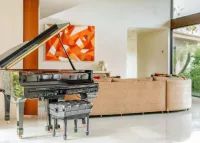
-

- Dave Decker
Frank Sinatra House - Twin Palms Estate
Sinatra started coming to Palm Springs in the late 1940s. He had been told about it by his close friend, the composer Jimmy Van Heusen, who had stopped for fuel there while flying to Los Angeles. Van Heusen told Sinatra of the beauty of the desert later that day, and Sinatra insisted that they fly there that evening. Fellow acquaintances of Sinatra's who had also started frequenting Palm Springs in the 1940s included Lana Turner and Dinah Shore, and the actress Ava Gardner who was to become his second wife. On 1 May 1947 Sinatra walked into the offices of E. Stewart Williams, wearing a white sailor cap and eating an ice cream cone, and requested that the firm build him a Georgian style house as a weekend residence; he had recently signed a film contract with Metro Goldwyn Meyer, and had made his first $1 million. Feeling that the Georgian style was unsuitable for the extremes of the desert environment, Williams showed Sinatra two architectural drawings, one of the Georgian design, and the other of a single-story modern house. Sinatra chose the modern design, and the house was to be Williams's first residential commission. Williams's brother and architectural partner, Roger, later said that he was "so glad" that Sinatra chose the modern design, believing that "We'd have been ruined if we'd been forced to build Georgian in the desert".[4] Sinatra demanded that the house be completed in time for a Christmas party he intended to host. The house was eventually finished shortly before the new year at a cost of $150,000. Sinatra lived in the house from its completion in 1947 to 1954, and sold it in 1957. Before selling it, Sinatra rented the house to Moss Hart so that he and Judy Garland could re-write A Star is Born. Twin Palms was subsequently photographed by Julius Shulman. The house was later occupied by a Texas couple for 43 years who let it become dilapidated, until its 1997 sale for $135,000. It was subsequently sold in 2000 for $1,345,000 and for $2.9 million in 2005. Two Palms was offered for sale in 2010 for $3.25 million. Twin Palms is a single-story residential building, 4,500sq ft in size with 4 bedrooms and 7 bathrooms, constructed around long horizontal lines framed with steel and aluminum and windows that stretch to the ground. The house has a flat and slightly sloping roof, and a piano shaped swimming pool, the design of which was entirely accidental. The house is named for the two palm trees that stand next to it. The house would become an early emblematic example of a style known as desert modernism.
Frank Sinatra House - Twin Palms Estate
Sinatra started coming to Palm Springs in the late 1940s. He had been told about it by his close friend, the composer Jimmy Van Heusen, who had stopped for fuel there while flying to Los Angeles. Van Heusen told Sinatra of the beauty of the desert later that day, and Sinatra insisted that they fly there that evening. Fellow acquaintances of Sinatra's who had also started frequenting Palm Springs in the 1940s included Lana Turner and Dinah Shore, and the actress Ava Gardner who was to become his second wife. On 1 May 1947 Sinatra walked into the offices of E. Stewart Williams, wearing a white sailor cap and eating an ice cream cone, and requested that the firm build him a Georgian style house as a weekend residence; he had recently signed a film contract with Metro Goldwyn Meyer, and had made his first $1 million. Feeling that the Georgian style was unsuitable for the extremes of the desert environment, Williams showed Sinatra two architectural drawings, one of the Georgian design, and the other of a single-story modern house. Sinatra chose the modern design, and the house was to be Williams's first residential commission. Williams's brother and architectural partner, Roger, later said that he was "so glad" that Sinatra chose the modern design, believing that "We'd have been ruined if we'd been forced to build Georgian in the desert".[4] Sinatra demanded that the house be completed in time for a Christmas party he intended to host. The house was eventually finished shortly before the new year at a cost of $150,000. Sinatra lived in the house from its completion in 1947 to 1954, and sold it in 1957. Before selling it, Sinatra rented the house to Moss Hart so that he and Judy Garland could re-write A Star is Born. Twin Palms was subsequently photographed by Julius Shulman. The house was later occupied by a Texas couple for 43 years who let it become dilapidated, until its 1997 sale for $135,000. It was subsequently sold in 2000 for $1,345,000 and for $2.9 million in 2005. Two Palms was offered for sale in 2010 for $3.25 million. Twin Palms is a single-story residential building, 4,500sq ft in size with 4 bedrooms and 7 bathrooms, constructed around long horizontal lines framed with steel and aluminum and windows that stretch to the ground. The house has a flat and slightly sloping roof, and a piano shaped swimming pool, the design of which was entirely accidental. The house is named for the two palm trees that stand next to it. The house would become an early emblematic example of a style known as desert modernism.
Frank Sinatra House - Twin Palms Estate
Sinatra started coming to Palm Springs in the late 1940s. He had been told about it by his close friend, the composer Jimmy Van Heusen, who had stopped for fuel there while flying to Los Angeles. Van Heusen told Sinatra of the beauty of the desert later that day, and Sinatra insisted that they fly there that evening. Fellow acquaintances of Sinatra's who had also started frequenting Palm Springs in the 1940s included Lana Turner and Dinah Shore, and the actress Ava Gardner who was to become his second wife. On 1 May 1947 Sinatra walked into the offices of E. Stewart Williams, wearing a white sailor cap and eating an ice cream cone, and requested that the firm build him a Georgian style house as a weekend residence; he had recently signed a film contract with Metro Goldwyn Meyer, and had made his first $1 million. Feeling that the Georgian style was unsuitable for the extremes of the desert environment, Williams showed Sinatra two architectural drawings, one of the Georgian design, and the other of a single-story modern house. Sinatra chose the modern design, and the house was to be Williams's first residential commission. Williams's brother and architectural partner, Roger, later said that he was "so glad" that Sinatra chose the modern design, believing that "We'd have been ruined if we'd been forced to build Georgian in the desert".[4] Sinatra demanded that the house be completed in time for a Christmas party he intended to host.The house was eventually finished shortly before the new year at a cost of $150,000. Sinatra lived in the house from its completion in 1947 to 1954, and sold it in 1957. Before selling it, Sinatra rented the house to Moss Hart so that he and Judy Garland could re-write A Star is Born. Twin Palms was subsequently photographed by Julius Shulman.
The house was later occupied by a Texas couple for 43 years who let it become dilapidated, until its 1997 sale for $135,000. It was subsequently sold in 2000 for $1,345,000 and for $2.9 million in 2005. Two Palms was offered for sale in 2010 for $3.25 million.
Twin Palms is a single-story residential building, 4,500sq ft in size with 4 bedrooms and 7 bathrooms, constructed around long horizontal lines framed with steel and aluminum and windows that stretch to the ground. The house has a flat and slightly sloping roof, and a piano shaped swimming pool, the design of which was entirely accidental. The house is named for the two palm trees that stand next to it. The house would become an early emblematic example of a style known as desert modernism.
Posted Date
Nov 08, 2021
Historical Record Date
Dec 26, 2016
Source Name
Wikipedia - Photos from AirBNB
Source Website
Delete Story
Are you sure you want to delete this story?
Nov 21, 2015

-

- Dave D
The Homes He Lived In: Frank Sinatra in Palm Springs
Excerpt from the article The Homes He Lived In: Frank Sinatra in Palm Springs by Scott. Published 11/21/2015. In 1947, Frank Sinatra first visited Palm Springs and changed the course of the city forever. Already a hub for health tourists searching for drier air on their vacation, the city had many hotels. Sinatra, arrived looking for a weekend home for his family to get away from Hollywood. Following his Oscar win for The House I Live In, the process began for constructing his weekend getaway in Palm Springs. The house was known as ‘Twin Palms’. It was originally commissioned as a Georgian mansion, but Sinatra was convinced by the architect to make a more non-traditional, modern rectangular house. This change delayed the expected Christmas move in, but only by a handful of days. The Sinatras were able to throw a fancy New Years’ Eve party for its christening. The house measures over 4,500 square feet and features a grand piano-shaped pool as well as an entire wing devoted to the master bedroom. Sinatra had a recording studio linked to the house – unfortunately, this is no longer in operating condition. Twin Palms was a part of the neighborhood known as the 'Movie Colony', an exclusive sector of town which bore the claim to fame of having many 40s and 50s Hollywood stars as residents. He was known to hang a flag bearing the Jack Daniels emblem to let neighbors know it was time to visit for cocktails at Twin Palms. As part of the Movie Colony, Sinatra often played golf at the Indian Canyons Golf Resort, where fellow resident Walt Disney eventually donated a fountain. After divorcing his first wife Nancy in 1948, the house soon became the site of his marriage to Ava Gardner. The pair were known to throw lavish parties at the estate. Twin Palms was also the site of many of their fights, including one instance where Sinatra reportedly threw a champagne bottle at Gardner, cracking a sink, and - according to Lee Server's book Ava Gardner: Love is Nothing - another where he kicked her and Lana Turner out of the house, throwing Gardner’s possessions onto the driveway. Film buffs may recognize the house from the 1950 film The Damned Don’t Cry, starring Joan Crawford, where it features as the house of a mobster. It’s said that Sinatra loaned his house out to Crawford and the film’s team as a personal favor. However, they were only allowed to use exterior shots of the house. Sinatra, true to his fashion, did not stay in the house for more than ten years, moving out in 1957 after his divorce from Gardner. The house has gone under some renovations and is now available for rentals for upwards of $2,000 a night.
The Homes He Lived In: Frank Sinatra in Palm Springs
Excerpt from the article The Homes He Lived In: Frank Sinatra in Palm Springs by Scott. Published 11/21/2015. In 1947, Frank Sinatra first visited Palm Springs and changed the course of the city forever. Already a hub for health tourists searching for drier air on their vacation, the city had many hotels. Sinatra, arrived looking for a weekend home for his family to get away from Hollywood. Following his Oscar win for The House I Live In, the process began for constructing his weekend getaway in Palm Springs. The house was known as ‘Twin Palms’. It was originally commissioned as a Georgian mansion, but Sinatra was convinced by the architect to make a more non-traditional, modern rectangular house. This change delayed the expected Christmas move in, but only by a handful of days. The Sinatras were able to throw a fancy New Years’ Eve party for its christening. The house measures over 4,500 square feet and features a grand piano-shaped pool as well as an entire wing devoted to the master bedroom. Sinatra had a recording studio linked to the house – unfortunately, this is no longer in operating condition. Twin Palms was a part of the neighborhood known as the 'Movie Colony', an exclusive sector of town which bore the claim to fame of having many 40s and 50s Hollywood stars as residents. He was known to hang a flag bearing the Jack Daniels emblem to let neighbors know it was time to visit for cocktails at Twin Palms. As part of the Movie Colony, Sinatra often played golf at the Indian Canyons Golf Resort, where fellow resident Walt Disney eventually donated a fountain. After divorcing his first wife Nancy in 1948, the house soon became the site of his marriage to Ava Gardner. The pair were known to throw lavish parties at the estate. Twin Palms was also the site of many of their fights, including one instance where Sinatra reportedly threw a champagne bottle at Gardner, cracking a sink, and - according to Lee Server's book Ava Gardner: Love is Nothing - another where he kicked her and Lana Turner out of the house, throwing Gardner’s possessions onto the driveway. Film buffs may recognize the house from the 1950 film The Damned Don’t Cry, starring Joan Crawford, where it features as the house of a mobster. It’s said that Sinatra loaned his house out to Crawford and the film’s team as a personal favor. However, they were only allowed to use exterior shots of the house. Sinatra, true to his fashion, did not stay in the house for more than ten years, moving out in 1957 after his divorce from Gardner. The house has gone under some renovations and is now available for rentals for upwards of $2,000 a night.
Nov 21, 2015
The Homes He Lived In: Frank Sinatra in Palm Springs
Excerpt from the article The Homes He Lived In: Frank Sinatra in Palm Springs by Scott. Published 11/21/2015.In 1947, Frank Sinatra first visited Palm Springs and changed the course of the city forever. Already a hub for health tourists searching for drier air on their vacation, the city had many hotels. Sinatra, arrived looking for a weekend home for his family to get away from Hollywood. Following his Oscar win for The House I Live In, the process began for constructing his weekend getaway in Palm Springs. The house was known as ‘Twin Palms’.
It was originally commissioned as a Georgian mansion, but Sinatra was convinced by the architect to make a more non-traditional, modern rectangular house. This change delayed the expected Christmas move in, but only by a handful of days. The Sinatras were able to throw a fancy New Years’ Eve party for its christening.
The house measures over 4,500 square feet and features a grand piano-shaped pool as well as an entire wing devoted to the master bedroom. Sinatra had a recording studio linked to the house – unfortunately, this is no longer in operating condition.
Twin Palms was a part of the neighborhood known as the 'Movie Colony', an exclusive sector of town which bore the claim to fame of having many 40s and 50s Hollywood stars as residents. He was known to hang a flag bearing the Jack Daniels emblem to let neighbors know it was time to visit for cocktails at Twin Palms. As part of the Movie Colony, Sinatra often played golf at the Indian Canyons Golf Resort, where fellow resident Walt Disney eventually donated a fountain.
After divorcing his first wife Nancy in 1948, the house soon became the site of his marriage to Ava Gardner. The pair were known to throw lavish parties at the estate. Twin Palms was also the site of many of their fights, including one instance where Sinatra reportedly threw a champagne bottle at Gardner, cracking a sink, and - according to Lee Server's book Ava Gardner: Love is Nothing - another where he kicked her and Lana Turner out of the house, throwing Gardner’s possessions onto the driveway.
Film buffs may recognize the house from the 1950 film The Damned Don’t Cry, starring Joan Crawford, where it features as the house of a mobster. It’s said that Sinatra loaned his house out to Crawford and the film’s team as a personal favor. However, they were only allowed to use exterior shots of the house.
Sinatra, true to his fashion, did not stay in the house for more than ten years, moving out in 1957 after his divorce from Gardner. The house has gone under some renovations and is now available for rentals for upwards of $2,000 a night.
Posted Date
Nov 30, 2021
Historical Record Date
Nov 21, 2015
Source Name
WNYC
Delete Story
Are you sure you want to delete this story?
Oct 05, 1965
Oct 05, 1965
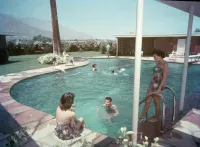
At the pool
Female and male guests relax near and swim in the piano-shaped swimming pool at Twin Palms, the estate belonging to American singer and actor Frank Sinatra (1915 - 1998), Palm Springs, California, 195
At the pool
Female and male guests relax near and swim in the piano-shaped swimming pool at Twin Palms, the estate belonging to American singer and actor Frank Sinatra (1915 - 1998), Palm Springs, California, 195Posted Date
Nov 30, 2021
Historical Record Date
Oct 05, 1965
Source Name
WNYC
Delete Story
Are you sure you want to delete this story?
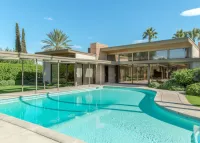
-

- Dave Decker
1145 East Vía Colusa, Palm Springs, CA 92262, USA
Twin Palms, also known as the Frank Sinatra House, at 1148 East Alejo Rd is a mid-century modern house in the Movie Colony–El Mirador neighborhood of Palm Springs, California. The house was designed by E. Stewart Williams, to a commission from the American singer and actor Frank Sinatra. The house was Williams's first residential commission.
1145 East Vía Colusa, Palm Springs, CA 92262, USA
Twin Palms, also known as the Frank Sinatra House, at 1148 East Alejo Rd is a mid-century modern house in the Movie Colony–El Mirador neighborhood of Palm Springs, California. The house was designed by E. Stewart Williams, to a commission from the American singer and actor Frank Sinatra. The house was Williams's first residential commission.
1145 East Vía Colusa, Palm Springs, CA 92262, USA
Twin Palms, also known as the Frank Sinatra House, at 1148 East Alejo Rd is a mid-century modern house in the Movie Colony–El Mirador neighborhood of Palm Springs, California. The house was designed by E. Stewart Williams, to a commission from the American singer and actor Frank Sinatra. The house was Williams's first residential commission.Posted Date
Nov 08, 2021
Delete Story
Are you sure you want to delete this story?


